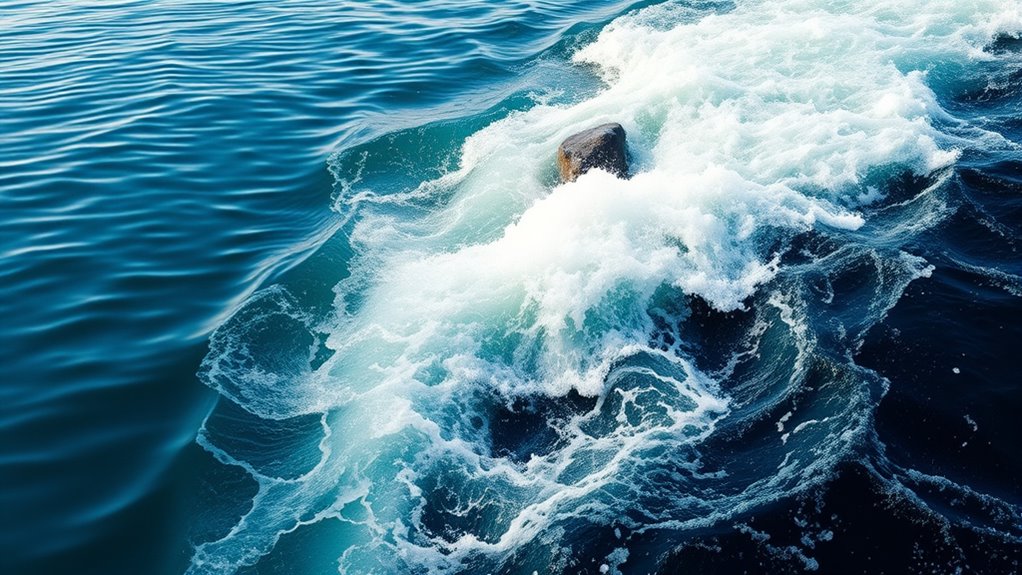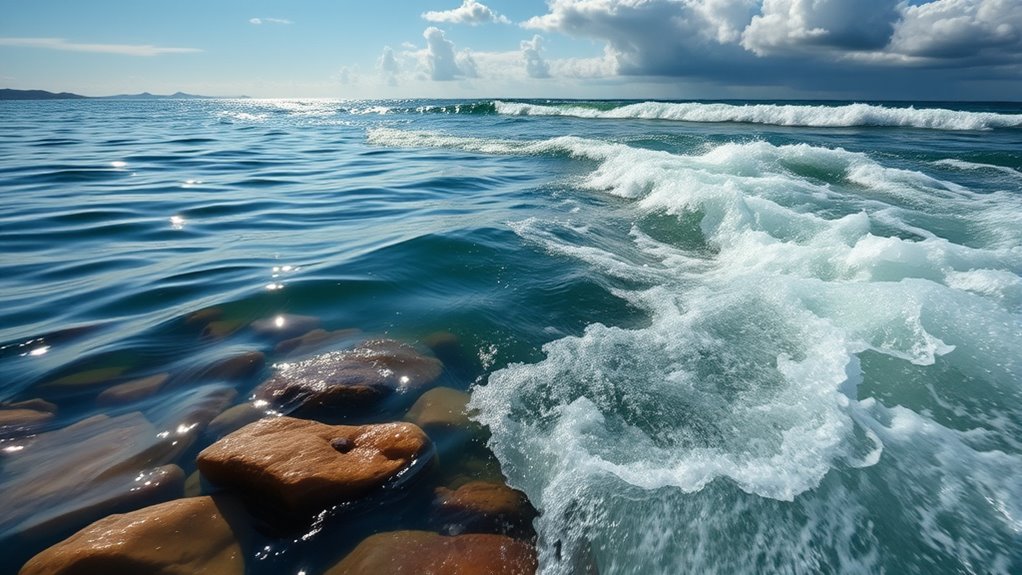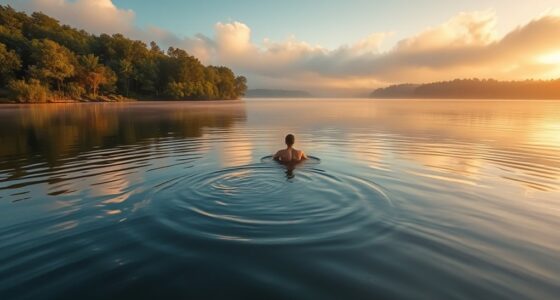In lakes, currents mainly move gently in circles driven by winds and temperature differences, so your float will drift with slow, predictable loops. In rivers, gravity dominates, making the current fast and unidirectional, pushing your float swiftly downstream. In seas and oceans, currents are powerful and influenced by wind, temperature, Earth’s spin, and coastlines, creating large, persistent flows that can carry your float across long distances. If you keep exploring, you’ll uncover more about how these currents shape float behavior.
Key Takeaways
- Lake currents are mainly wind-driven surface flows forming gentle gyres, with vertical mixing caused by temperature gradients.
- River currents are strong, unidirectional, gravity-driven flows that dominate over wind influence.
- Sea and ocean currents are large-scale, persistent flows influenced by wind, Earth’s rotation, temperature, and coastline shape.
- Wind significantly impacts surface currents in lakes and seas but has minimal effect on river flow.
- Temperature gradients create vertical and horizontal water movement, affecting currents differently in lakes, rivers, and oceans.

Have you ever wondered what drives the flowing movement of water in lakes, rivers, and seas? The answer lies in a combination of natural forces, with wind influence and temperature gradients playing key roles. These factors shape the way currents develop and behave in different bodies of water, affecting everything from tiny floats to large ships. Understanding these differences helps you grasp how water moves and how it can impact navigation, ecology, and even your recreational activities.
Water movement is driven by wind and temperature differences affecting lakes, rivers, and seas.
In lakes, currents are generally less powerful than in oceans or large rivers. Wind influence is a significant factor here; when the wind blows across a lake’s surface, it transfers energy to the water, creating surface currents. These currents tend to be shallow and move in the direction of the wind, often forming circular patterns called gyres. Temperature gradients also contribute, especially in larger lakes. During sunny days, the sun heats the surface, causing temperature differences between the top and bottom layers of water. This stratification can lead to vertical currents, where warmer water rises and cooler water sinks, mixing the layers to some extent. As a result, float movement on lakes can be affected by these subtle current patterns, which are often gentle but persistent.
Rivers, on the other hand, primarily rely on the force of gravity to produce their flow. They have a unidirectional movement from higher to lower elevations. Wind influence is usually minimal in rivers because their flow is so strong and directed by the terrain. Temperature gradients can still play a role, especially during seasonal changes. For example, in colder months, the surface might freeze, creating a barrier that affects how floats drift and how water circulates underneath. During summer, surface heating can cause slight variations in flow speed, but these are typically minor compared to the river’s overall movement driven by gravity.
Seas and oceans exhibit the most complex currents, influenced by a combination of wind, temperature gradients, Earth’s rotation, and the shape of the coastline. Wind influence is essential here; persistent winds, like trade winds and westerlies, generate surface currents that can span thousands of miles. Temperature gradients are also fundamental, especially in large ocean basins, where differences in water temperature create density variations. Warm surface waters tend to stay near the equator, while cooler, denser waters sink toward the poles, forming thermohaline circulation. This process, along with the Coriolis effect from the Earth’s rotation, results in vast, persistent currents like the Gulf Stream. These currents can carry floats across great distances, shaping marine life distribution and climate patterns.
Frequently Asked Questions
How Do Temperature Differences Influence Current Strength in Lakes and Seas?
Temperature differences directly affect current strength through thermal layering and temperature gradients. In lakes and seas, warmer surface water sits on colder layers, creating thermal layering that slows down mixing. Steeper temperature gradients cause stronger currents as the water moves to balance the differences. You’ll notice that in areas with significant temperature variation, currents become more vigorous, influencing how floats drift and how water circulates throughout the environment.
What Role Do Underwater Topography Features Play in Current Patterns?
You’ll find that underwater topography, like submarine ridges and underwater valleys, markedly shapes current patterns. These features guide water flow, creating upwellings, eddies, and changes in speed. Submarine ridges can block or redirect currents, while valleys channel water, intensifying flow in certain areas. Exploring these features reveals how the ocean’s depths influence surface currents, making your understanding of marine navigation and ecosystems more accurate and fascinating.
How Do Seasonal Changes Affect Current Directions in Lakes and Rivers?
Seasonal wind patterns and ice melt dynamics substantially influence current directions in lakes and rivers. During warmer months, winds often shift, creating currents that flow differently than in winter. Ice melt can cause water to move toward the deeper parts of a lake or downstream in rivers. You’ll notice these seasonal changes alter flow directions, making currents more predictable in some seasons and more variable in others.
Can Human Activities Significantly Alter Natural Current Flows?
Human interventions act like a giant hand stirring the water, often disrupting natural current flows. Pollution effects, such as chemicals or waste, can create barriers or alter the water’s rhythm, turning smooth flows into chaotic swirls. Your activities—like damming, urban runoff, or deforestation—significantly reshape currents, impacting ecosystems and water quality. It’s a reminder that your actions ripple through the environment, changing the dance of nature’s currents.
How Do Currents Impact Aquatic Life and Ecosystems in Different Water Bodies?
Currents shape aquatic life and ecosystems by influencing nutrient cycling and predator-prey dynamics. You’ll find that strong currents can disperse nutrients, supporting diverse plant and animal life, while slow currents may lead to nutrient buildup, risking dead zones. They also impact predator-prey interactions, as swift flows can help predators hunt or hide, shaping survival strategies. Overall, currents are essential in maintaining balanced ecosystems across lakes, rivers, and seas.
Conclusion
Understanding how currents differ in lakes, rivers, and the sea helps you stay safe and enjoy your time outdoors. For example, if you’re kayaking in a calm lake, you’ll notice gentle, predictable currents, unlike the strong, unpredictable sea tides that can pull you away. By recognizing these differences, you can plan better and navigate confidently, whether you’re exploring a serene lake or the vast ocean. Stay informed, stay safe, and enjoy your adventures!










